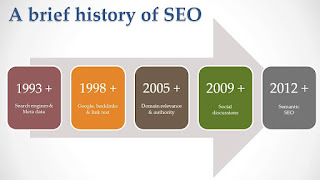In the last blog, we had just peeped into history and evolution of SEO, techniques used, its updates. As we know SEO can be split into On-Page SEO and Off-Page SEO. So in this blog lets see what is On-Page SEO.
On-Page Optimisation is also known as On-Site SEO is the task of optimizing elements on a web page. In order to attain high ranking and earn more traffic in the search engine, we optimize both the content and HTML source code of a page. It also helps users to easily understand what the page is about. In short by doing On-Page optimization search engine can serve high-quality content for their query. Let us have a glance through the effective ways to increase page ranking on search engine.
7 Substantial On-Page SEO Techniques
Title Tag
A catching or good title in SEO pages plays an important role. A user first sees the titles in the search results. Google display 50 - 60 characters of a title tag. So its suggested limiting the characters around this range. Google displays titles currently at 512 pixels. They are the major factor in helping search engines understand what your page is about. Google check for CTR(Click Through Rate) as an element for how relevant you are for a specific keyword.
Page Title is the clickable title of a web page that appears with the result on the Search engine results page. Page title tells people and search engine the topic of the web page. They also tell search engines an estimate of how relevant a page is to searchers query. Page title must be relevant and accurate to the page's content.
Title tags are used in 3 key places:
- Search Engine Results Page(SERPs).
- In Browsers.
- In social network.
Page Titles in SEO
1. Keep titles about 55-60 characters long. Don't use a too short title, long title, don't duplicate it.
2.Use target keyword in titles.
3.In the title describe the content of the page in the best possible way.
4.Use keywords like How, Why, What and Where.
5.Use words like best, review, ultimate.
6.Don't duplicate the title.
7.Use brand name wisely.
8.Keep it simple.
Meta Description
A snippet includes title, URL, meta description. Let's see what is meta description. It's HTML attributes that give a summary of web pages. It varies between 155-160 characters. It let visitors know what your page is about before they click on it. Meta Description has a large impact on CTR(Click Through Rate) on Google which can positively impact a pages ability to rank.
- If users query for a keyword or question then if Google lists it then we will get one impression.
- If we get 2500 impressions but fewer clicks because it's in 5th position. If Click Through Rate(CTR) is less than we must optimize our meta description.
- Its always good to include focusing keywords in the meta description.We can also include offers rebate, discounts to increase clicks.
- Meta description must be unique.But the content on the page can be similar to the meta description.It must be very impressive.
Body Section Optimization
For an SEO Analyst writing contents for a page is very important, content needs to be broken up into paragraphs and should be given headings. Headings should be keyword rich so that search engine can understand your content easily, focusing words should nearly appear 4 times in body section. You should include only one H1 in one page, use a relevant keyword in it, use 7 to 8 words in it. Subheadings, minor headings can be given using H2, H3.Long contents in the body help to achieve high rank.
Keyword Optimization
We should and use relevant keywords to attain a good traffic for our site. Its one of the hardest task and most of the site owners, bloggers don't spend enough time for it. In order to attain the traffic select and use relevant keywords. Let us see where all we need to include the keywords.
- The title should contain the relevant keyword.
- There must be keywords in the links(anchor text). Inbound links, internal links, outbound links all should have your top optimized keywords.
- Optimise keywords in the pictures of your pages.
- Include keywords in the URL structure.
Keyword Density
It is the percentage value of the number of times a keyword occurs in a webpage. It is very important to have the necessary keywords. But don't overuse and make your site rank low. Use keywords wisely in your content. Try to keep keyword density in the range 2-5%.
Image Optimization
Using images within your content is very appealing to the readers.Important things to be noted while optimizing your image.
- Name your image in plain English in a descriptive way.
- Optimise alt-tag for your images.
- Create a master plan for how to use your product angles and image dimensions.
- Don't use large images since it will overload the page.
Authorship Optimization
If a single person writes in more than one blog then he/she may have more authorship. Similarly, if more than one person writes in a page, then also the Authorship of the page increase. Authorship increases the visibility of the page and leads to achieve more links to the page. It is a noteworthy process in marketing strategy.
On-Page optimization is an important aspect of an affluent search engine optimization. Even if it's crawling of the search engine or indexing of page On-Page Optimisation plays an important role in ranking. You can also refer to my last blog based on History and Evolution of SEO to dive deep into SEO.







